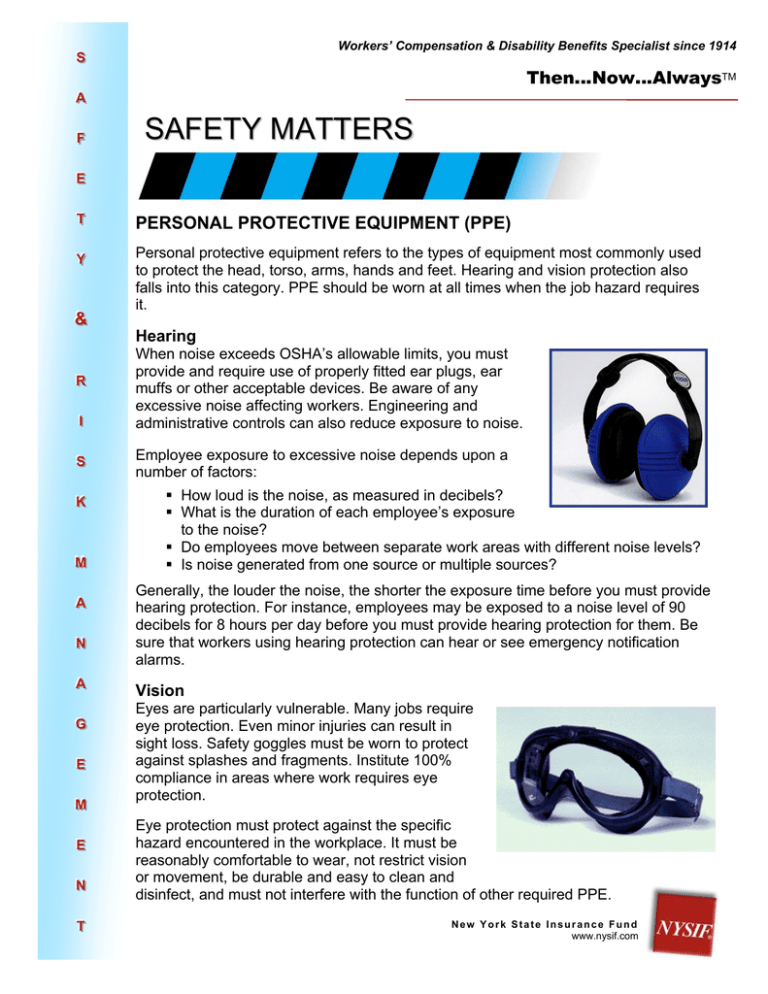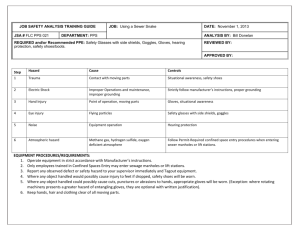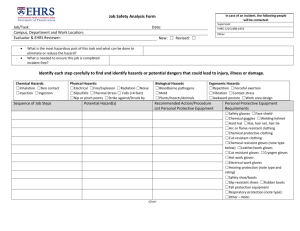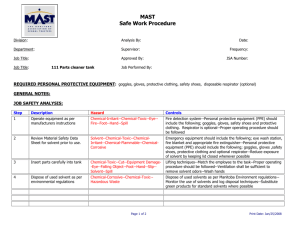Personal Protective Equipment
advertisement

Workers’ Compensation & Disability Benefits Specialist since 1914 SS Then…Now…AlwaysTM A A FF SAFETY MATTERS EE TT PERSONAL PROTECTIVE EQUIPMENT (PPE) YY Personal protective equipment refers to the types of equipment most commonly used to protect the head, torso, arms, hands and feet. Hearing and vision protection also falls into this category. PPE should be worn at all times when the job hazard requires it. & & Hearing R R II SS K K M M A A N N A A G G EE M M EE N N TT When noise exceeds OSHA’s allowable limits, you must provide and require use of properly fitted ear plugs, ear muffs or other acceptable devices. Be aware of any excessive noise affecting workers. Engineering and administrative controls can also reduce exposure to noise. Employee exposure to excessive noise depends upon a number of factors: How loud is the noise, as measured in decibels? What is the duration of each employee’s exposure to the noise? Do employees move between separate work areas with different noise levels? Is noise generated from one source or multiple sources? Generally, the louder the noise, the shorter the exposure time before you must provide hearing protection. For instance, employees may be exposed to a noise level of 90 decibels for 8 hours per day before you must provide hearing protection for them. Be sure that workers using hearing protection can hear or see emergency notification alarms. Vision Eyes are particularly vulnerable. Many jobs require eye protection. Even minor injuries can result in sight loss. Safety goggles must be worn to protect against splashes and fragments. Institute 100% compliance in areas where work requires eye protection. Eye protection must protect against the specific hazard encountered in the workplace. It must be reasonably comfortable to wear, not restrict vision or movement, be durable and easy to clean and disinfect, and must not interfere with the function of other required PPE. New York State Insurance Fund www.nysif.com Skin Exposure to chemicals or pollutants requires proper body protection. As with all protective equipment, protective clothing is available to protect against specific hazards. You need to provide personal protective equipment for the parts of the body exposed to possible injury. Depending upon hazards in your workplace, you may need to provide your employees with one or more of the following: Vests Jackets Aprons Coveralls Surgical gowns Full body suits Hand protection Face Grinding and chipping operators, welders and employees exposed to many other hazards, require facial protection. Some examples of facial protection are: Face shields - Transparent sheets of plastic extend from the brow to below the chin across the entire width of the employee’s head to protect your employees’ face from dust and potential splashes or sprays of hazardous liquids. Goggles - Protect the eyes and the facial area immediately surrounding the eyes from impact, dust and splashes. Some goggles fit over corrective lenses. Welding shields - Protect your employees’ eyes from burns caused by infrared or intense radiant light, and they protect face and eyes from flying sparks, metal spatter and chips produced during welding, brazing, soldering and cutting. Laser safety goggles - Provide a range of protection against the intense concentrations of light produced by lasers. The type of laser safety goggles you choose will depend upon the equipment and operating conditions in your workplace. Head Mandate use of approved hard hats for any work that has an overhead hazard. Don’t use metallic hats near electrical hazards. Hard hats are divided into three industrial classes: Class A - These helmets are for general service. They provide good impact protection but limited voltage protection. They are used mainly in mining, building construction and manufacturing. Class B - These helmets should be used if your employees are engaged in electrical work. They protect against falling objects and high-voltage shock and burns. Class C - These helmets are comfortable, lightweight and offer limited protection. They do not protect against falling objects or electric shock. Look at the inside of any protective helmet you are considering for your employees, and you should see a label showing the manufacturer’s name, the ANSI standard it meets and its class. Safety & Risk Management 2 New York State Insurance Fund www.nysif.com Feet Safety shoes suited to the hazard sharply reduce injuries to toes and feet. Where puncture wounds to the foot are a hazard, as in construction/demolition, use stainless steel insoles. High heels, sneakers, open-toed or worn-down shoes increase accident potential. Consider non-slip shoes when hazards exist. Hands Handling heavy, rough or sharp materials requires gloves. Use nonconductive gloves for high voltages, metal gloves for cutting and chemical-resistant gloves for a variety of industrial exposures. Gloves made from a wide variety of materials are designed for virtually every workplace hazard. In general, they may be divided into four groups: Durable work gloves made of metal mesh, leather, or canvas Fabric and coated fabric gloves Chemical and liquid resistant gloves Insulated rubber gloves Some pointers on the use of PPE: Workers should be convinced of the need for safety equipment, with supervisors setting the example. The following is very important in all situations requiring personal protective equipment: 1. Protection should cover all exposed areas. For example, unless a hazard is strictly frontal, goggles should have side shields. Provide appropriate face shields for jobs involving flying particles, exposure to chemicals, heat, molten metals, or hot solutions. 2. Durability is important – Safety equipment that deteriorates during use can be very dangerous. 3. Reliability of manufacturer – Always worth considering when buying safety equipment. 4. Comfort – At the very least, uncomfortable protective equipment reduces productivity. At worst, workers use every opportunity to avoid wearing it. Order proper sizes and test for fit. 5. Appearance – Leads to the most important concern, acceptance. 6. Worker acceptance – Obtained through proper safety training and enforcement of work rules. 7. Comply with American National Standards Institute (ANSI) standards for protective equipment when applicable. Safety & Risk Management 3 New York State Insurance Fund www.nysif.com



